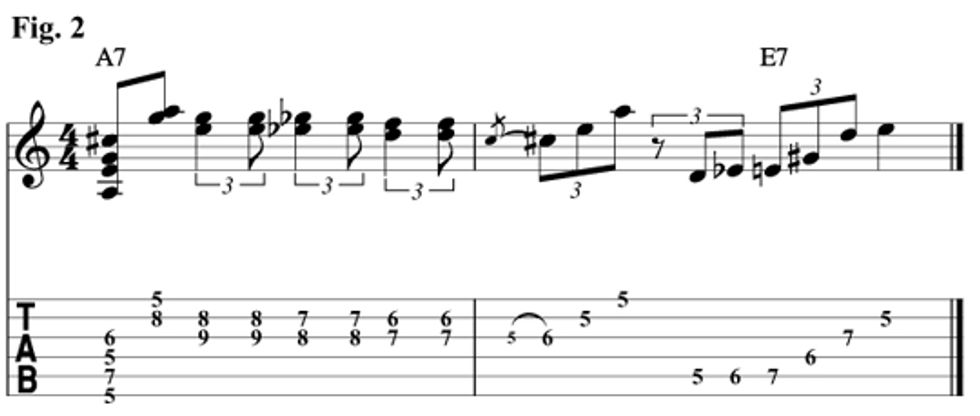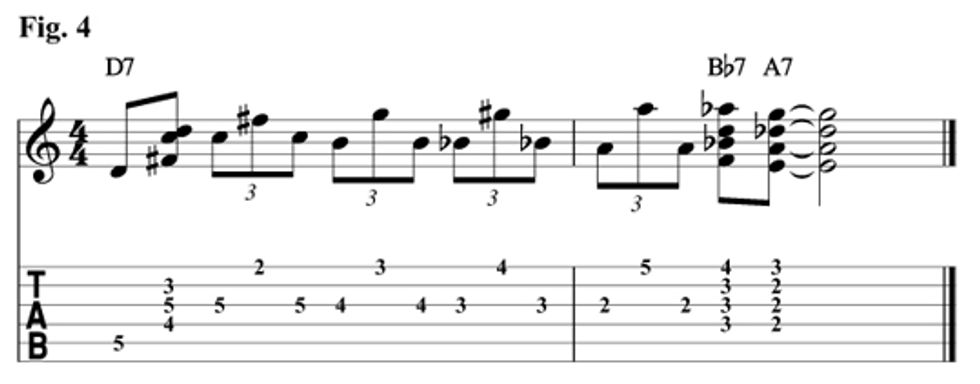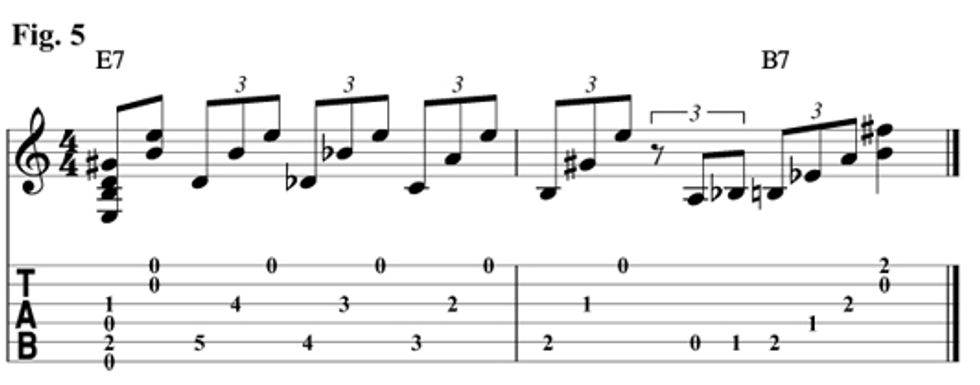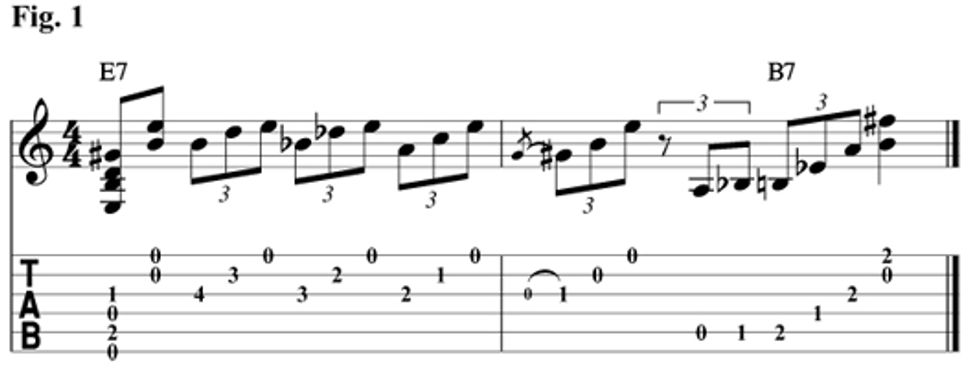Using triads to illustrate how to construct turnarounds
In this lesson we’ll use triads just one more time to create cool traditional blues turnarounds. Turnarounds are a way to get from the last two bars of a blues back to the first bar. These turnarounds are traditional electric blues in the style of Freddie King and Buddy Guy. Hopefully after this installment you’ll be able to create your own with a full understanding of how these were created. Let’s get started.
Example 1 - Download Example Audio
Example 1 is the last two bars of an E blues. The first beat is an E7 chord, and then I took the third (G#) and the fifth (B) of an open position E major chord and moved them up a minor third, just as we did last month creating the seventh chords from triads. This is exactly the same idea, just a different application. This time, move the third (G#) and the fifth (B) up a minor third, three frets so that the third becomes the fifth (B) and the fifth becomes the flat seventh (D). Then, chromatically move them down to their original places. Notice, that I was able to play the root for each chromatic movement since the root is an open E string. Then, end on the five chord of E blues B7, with a little chromatic climb up.
Example 2 - Download Example Audio
In Example 2 I’ve transposed the same idea as Example 1 up a fourth to A blues. I’ve also changed the rhythm a little. Instead of an arrpegiated triplet figure I kept the triplet feel, making it a rhythmic chordal idea by removing the middle note of the triplet and replacing it with a rest. But just as I did in Example 1, I took the third (C#) and the fifth (E) and I moved them up a minor third so that the third (C#) becomes the fifth (E) and the fifth (E) becomes the flat seventh (G). Then I just chromatically moved them down to their original places. Then I ended on the five chord of A blues E7. Again, I used the same chromatic run from the fourth (D) up to the fifth (E) the root of the E7th chord.

Example 3 - Download Example Audio
Example 3 is again the last two bars of an E Blues. This time, I’ve chosen to use an E major triad from the D shape triad rooted on the second string. The third is on the first string, fourth fret (G#) and the fifth is on the third string, fourth fret (B). Just move those notes up three frets so that the third (G#) becomes the fifth (B), and the fifth (B) becomes the flat seventh (D). Then I change the rhythmic idea again, only this time, just strumming triplets for each chromatic movement. Notice that when I get down to the root triad E on beat one of the second measure of the phrase, I let it ring as a quarter note, then I play the five chord of E blues B7. This time instead of a chromatic run up to the root of the five chord, I approach the five chord from a half step above. I play C9 then B9—dominant chords’ sevenths, ninths, and thirteenths are all interchangeable. In this example, I thought that the ninths sound cooler than the seventh chords. I would recommend all ways trying the different extensions of the chords until you find the one that sounds the best.

Example 4 - Download Example Audio
Until this example, which is my favorite, we’ve used what is called parallel motion where the altered notes move in the same direction at the same intervallic distance. In Example 4, we're going use contrary motion. This means that the notes will move in different directions and the intervallic distance between the notes changes. In this example we are in D blues, and just as before we’ll start with the one chord D7. I’ve chosen to use a C7 shape moved up to D on the fifth fret. Then, for the triad I’ve used an open position D chord. This time I’m leaving the third (F#) in place, but I’m going to move the fifth (A) up three frets to C, the flat seventh of D7. The flat seventh (C) moves down chromatically until it gets back down to the fifth (A). The third is going to move chromatically up until it gets to A, the fifth of D7. This means at the end of the chromatic movement you’ll have A, the fifth, an octave apart—this is a very cool sound. Then, I end just as I do in Example 3 on the five chord A7, but from the half step above the Bb7 down to the A7.

Example 5 - Download Example Audio
Example 5 is just like Example 1, except for the fact that I invert the interval of the third and the fifth. In Example 1, the third was the lower of the two notes, making the intervallic distance a third. In Example 5, I’ve made the fifth the lower of the two notes. This makes our interval between the two notes a sixth. When you flip the notes over, it’s called an inversion. This changes the characteristic of the turnaround, giving it a lower more growling effect. This means that instead of using the open B string as my fifth, I’m going to use the fifth (B) on the second fret of the fifth string. I move this up the minor third as well as the first fret of the third string (G#). This make the fifth (B) the flat seventh (D), and the third (G#) a the fifth (B). Then, arpeggiate the two notes along with the open E string—which functions as the root in triplets—down chromatically till the flat seventh (D) and the fifth (B) become the fifth (B) and the third (G#) again.

Understanding turnarounds will really give you the edge you need to stand out of the crowd. Most players will use the same tired turnaround night after night. With the knowledge of how turnarounds are created, you will be able to create some very interesting ones as well as change up turnarounds on the fly both on gigs and at a jam. Hopefully these ideas will help you not only to have more fun as a rhythm player, but to be a better rhythm player as well.


